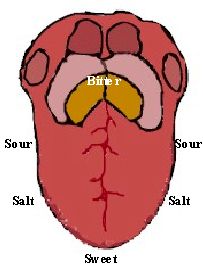Tongue Maps for Coffee
 Today
scientists have found that the textbook tongue maps are
misleading. Although they generally indicate where we
perceive sweet, sour, salt, and bitter, the maps are not
conclusive. In fact, we can perceive flavors all over
our tongue and each persons tongue is different. Some
of the more successful cupping programs have trained people
to use their knowledge of the regions outlined by tongue
maps to help them identify unknown flavors based upon
the position of the stimulus. However, since tasting regions
and flavor perception varies between people, this methodology
is incorrect. In addition, the interaction of flavors will
enhance and create entirely new flavors. Therefore, it
is important to train your tongue to discover your own
tongue map and study the relationship between different
stimuli.
Today
scientists have found that the textbook tongue maps are
misleading. Although they generally indicate where we
perceive sweet, sour, salt, and bitter, the maps are not
conclusive. In fact, we can perceive flavors all over
our tongue and each persons tongue is different. Some
of the more successful cupping programs have trained people
to use their knowledge of the regions outlined by tongue
maps to help them identify unknown flavors based upon
the position of the stimulus. However, since tasting regions
and flavor perception varies between people, this methodology
is incorrect. In addition, the interaction of flavors will
enhance and create entirely new flavors. Therefore, it
is important to train your tongue to discover your own
tongue map and study the relationship between different
stimuli.
Understanding your tongue is relatively
simple. I recommend gathering some sugar, citric acid,
salt, and quinine (available in tonic water). Dilute each
sample and paint your tongue in small sections with these
solutions using a small tipped paintbrush. Start with
the regions other than those indicated on the textbook
tongue maps. For instance, determine where on the tongue
you can perceive the sugar solution other than the tip
of your tongue. The tip of the tongue will be the most
sensitive region, but you may be able to perceive aspects
of sugar in other places. Next, experiment with various
concentrations and compare your results with other people.
It is essential to obtain an understanding of your perception
ability. Otherwise, our vocabulary to describe coffee will be skewed based upon our genetic predisposition to
being supertasters, nontasters, or medium tasters. If
you know you are a supertaster and you experience a extremely
bitter taste in a coffee, you must realize that 75% of
people will not agree with you.
After creating a map of your tongue begin
mixing the different flavors together and see how they
interact. Do they simply target both regions of the tongue
where the stimulus alone would occur or do you perceive
entirely new flavors in different regions? Continue experimenting
with different combinations until you finally have combined
all four together. Have someone else make up blind samples
for you to taste. Once you are able to identify each of
the components you have effectively mapped your tongue
and trained yourself to be able to approach much more
complex systems such as coffee. By using the maps you
create for your tongue, understanding your perception
ability, and understanding how flavors interact you are
more apt to describe coffee accurately.
Related
Articles
Coffee
Chemistry- Acidity
Coffee
Chemistry- Aroma
Coffee
Chemistry- Bitterness
Coffee
Cupping


